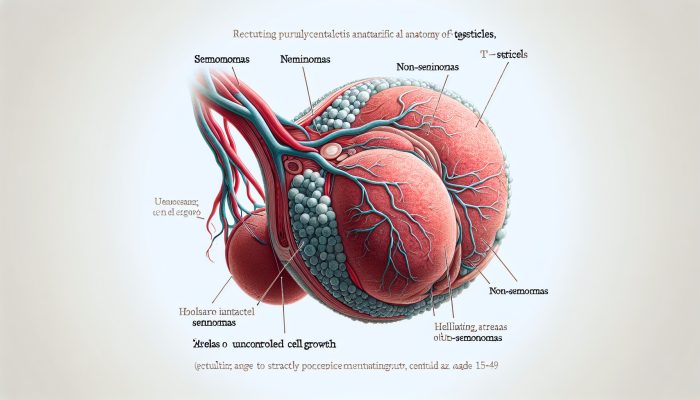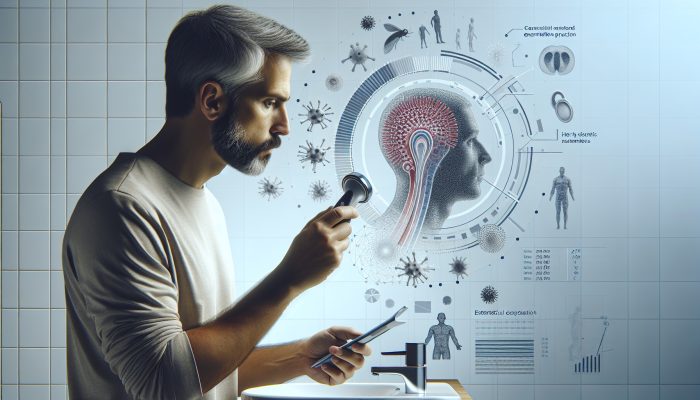Comprehensive Insights into Testicular Cancer and Its Consequences
Testicular Cancer Explained: A Thorough Examination

Testicular cancer represents a significant health challenge marked by the uncontrolled growth of cells within the testicles, resulting in the formation of tumors. This form of cancer is most frequently diagnosed in young men aged between 15 and 49, although it can occur at any age. The testicles play a vital role in the production of sperm and hormones like testosterone, rendering them susceptible to various cancers, with seminomas and non-seminomas being the most commonly identified types. Gaining a comprehensive understanding of this disease is crucial not only for increasing awareness but also for encouraging early detection through methods such as testicular cancer self-exams. Such proactive measures can significantly improve treatment outcomes and overall survival rates.
Prompt diagnosis is essential for maximizing the chances of effective treatment outcomes. Testicular cancer is known for its high treatability, especially when caught in its initial stages. With appropriate medical care, survival rates can soar above 95%, enabling many men to reclaim their health and lead fulfilling lives post-recovery. The disease may present in various forms and can sometimes lead to complications that impact fertility and hormonal balance. This highlights the necessity for men to be aware of their bodies and to remain watchful of any unusual changes that may arise, ultimately fostering a proactive approach to health care.
Identifying Key Risk Factors Linked to Testicular Cancer
Several risk factors can increase the likelihood of developing testicular cancer. A primary risk factor is a family history of the disease; men with relatives who have been diagnosed with testicular cancer face a greater risk, suggesting a potential genetic link. Furthermore, individuals with undescended testicles (referred to as cryptorchidism) are particularly at risk, especially if this condition was not surgically corrected during childhood. Recognizing these risk factors is crucial, as it empowers men to engage in informed discussions about testicular cancer self-exams and to adopt proactive health behaviors.
Age significantly influences risk as well; while testicular cancer can occur in men of any age, it is most frequently diagnosed in younger males, particularly those in their late teens to early thirties. Other contributing factors under consideration include hormonal levels, exposure to environmental toxins, and certain underlying medical conditions. Acknowledging these risks is vital for initiating meaningful conversations about testicular cancer self-exams and promoting proactive health strategies among men, fostering a culture of vigilance regarding their health and well-being.
Crucial Symptoms of Testicular Cancer to Watch For
Being able to recognize the symptoms of testicular cancer is essential for enabling early intervention. Common indicators often include a painless lump or swelling in one of the testicles, which may initially go unnoticed. Some men may also experience a sensation of heaviness in the scrotum, sometimes accompanied by a sudden build-up of fluid. Awareness of these symptoms can have a profound impact on treatment outcomes and overall health management.
Additional warning signs may involve alterations in the size or shape of the testicles or discomfort in the scrotal area. While these symptoms do not always indicate a cancer diagnosis, they require immediate medical evaluation. Early intervention can drastically influence treatment success, underscoring the importance of men routinely conducting testicular cancer self-exams. By maintaining vigilance, men can facilitate timely diagnoses, broaden treatment options, and ultimately save lives through proactive health engagement.
The Indispensable Role of Early Detection in Testicular Cancer

The importance of early detection in the context of testicular cancer is immense and cannot be emphasized enough. Research shows that when the disease is diagnosed at an early stage, the prognosis is particularly positive, with survival rates surpassing 95%. Regular self-examinations empower individuals to monitor their bodies for changes and quickly identify any irregularities that may develop.
Men should make it a habit to incorporate testicular cancer self-exams into their monthly health routines. The initial signs of testicular cancer can often be subtle and easily overlooked, but with diligence and awareness, these changes can be detected early, allowing for prompt medical evaluation. Understanding the symptoms and maintaining a proactive approach to health enables men to take charge of their well-being, fostering a culture where conversations about such health matters are normalized and accepted within society.
The Essential Role of Self-Examinations in Maintaining Testicular Health
The Critical Need for Regular Testicular Self-Exams
The significance of testicular cancer self-exams lies in their simplicity and effectiveness. Regular self-examinations can greatly enhance the chances of detecting testicular cancer while it is still in its early and most treatable stages. This proactive approach not only helps men become more familiar with their own bodies but also aids them in identifying any unusual changes that may occur over time, leading to earlier intervention and improved health outcomes.
Encouraging self-examinations as a consistent practice fosters greater awareness of personal health. Although many men may feel uncomfortable discussing issues related to testicular health, normalizing self-exams can help dismantle these barriers. By incorporating self-exams into one’s healthcare regimen, individuals are more likely to recognize changes early and seek necessary medical advice. The advantages of early detection extend beyond individual health; they contribute to enhanced public health outcomes, thereby alleviating the overall burden of cancer care on healthcare systems and promoting community wellness.
Recommended Frequency for Conducting Self-Examinations

Experts recommend performing testicular cancer self-exams at least once a month. Timing plays a crucial role; conducting these assessments after a warm bath or shower can enhance comfort and relaxation, making the examination process easier and more thorough. This relaxed state allows the skin to soften, ensuring a more comprehensive assessment.
Men should dedicate a few minutes each month to carry out these self-exams, ensuring they become an integral part of their health management routine. Establishing this habit encourages familiarity with one’s anatomy, making it easier to spot any irregularities. Setting reminders or associating self-exams with another monthly activity can help embed this practice into one’s routine, ensuring it does not get overlooked amidst the busyness of daily life.
Promoting Regular Self-Examinations Among Men
Incorporating testicular cancer self-exams into routine health checks is essential for raising awareness and reducing stigma surrounding male health issues. Normalizing these practices can significantly impact early detection rates and enhance health outcomes. Education is a critical component in this effort; discussions with friends, family, or healthcare professionals can motivate men to become more informed about their health.
Community initiatives can further amplify the importance of self-exams. Public awareness campaigns and educational programs can demystify testicular health and encourage men to take control of their well-being. By creating an environment that fosters open discussions, men can feel more empowered to actively participate in their health management and seek help when necessary.
A Step-by-Step Guide to Performing Self-Exams
Conducting a testicular cancer self-exam is a straightforward process that can be done in the comfort of one’s home. Begin by standing in front of a mirror to visually inspect the scrotum for any signs of swelling or abnormalities. Next, gently roll each testicle between your fingers, feeling for any lumps or changes in shape. It’s important to approach this examination with care, paying attention to any discomfort or unusual sensations that may arise during the process.
Taking your time during the self-exam is crucial. The objective is to become familiar with the normal texture and size of your testicles, making any changes more noticeable. If you discover any anomalies, such as lumps, swelling, or persistent discomfort, it’s vital to consult a healthcare professional for further evaluation. The sooner any concerns are addressed, the greater the chances of effective treatment and recovery.
Steps to Take If You Discover Something Unusual
Noticing an unusual change during a testicular cancer self-exam can be concerning; however, it’s essential to stay calm and take appropriate action. The first step is to consult a healthcare professional without hesitation. They can perform a thorough evaluation and determine whether additional tests are necessary. Many symptoms associated with testicular cancer can also be linked to benign conditions, making professional guidance crucial for accurate diagnosis.
Seeking medical advice facilitates early intervention, which significantly enhances treatment outcomes. Being aware of the necessity for prompt action encourages men to prioritize their health while overcoming feelings of embarrassment or stigma surrounding such discussions. Remember, early detection is critical; prioritizing health can lead to improved long-term survival rates and overall well-being.
Conducting a Self-Exam Efficiently
A Thorough Step-by-Step Method for Self-Exams
Beginning a testicular cancer self-exam starts with standing in front of a mirror. The first step involves visually inspecting each testicle for any signs of swelling or irregularities. The next step requires using your fingers to gently roll each testicle between them, ensuring you check for lumps or changes in consistency. This approach facilitates a thorough examination and promotes awareness of normal testicular anatomy.
It is advisable to use both hands during this examination. Place your index and middle fingers beneath the testicle while your thumb rests on top. This grip provides a secure hold, allowing you to feel for any unusual textures or lumps. Pay close attention to any differences in size, shape, or tenderness, as these could indicate underlying issues that may require further investigation and medical attention.
What to Look For During Self-Exams
While performing a self-exam, it’s imperative to know what specific signs to observe. Be vigilant for any lumps, swelling, or changes in the size or shape of the testicles. Any hardness or irregularity in texture can raise concerns. Additionally, take note of any discomfort or pain experienced during the exam, as these symptoms can also indicate potential health issues that need to be addressed.
Familiarity with the typical structure of your testicles can significantly assist in identifying abnormalities. Understanding the normal size and shape of your testicles will enable you to quickly recognize any changes. Keeping a mental note of these characteristics encourages vigilance and a proactive approach to maintaining testicular health and overall well-being.
When to Seek Professional Guidance
If you notice any unusual changes or symptoms during your testicular cancer self-exam, it’s essential to contact your GP as soon as possible. Early intervention can be critical for achieving successful treatment outcomes. It’s important to recognize that many men experience anxiety when confronted with potential health issues, but seeking professional advice is a necessary step in protecting your health and well-being.
Your GP can conduct further evaluations and, if necessary, refer you to a specialist for additional tests. Ignoring potential symptoms can lead to more serious consequences; therefore, taking a proactive approach to health is essential. Don’t hesitate—being proactive could save your life and ensure that you receive the care you need.
Recommended Frequency for Conducting Self-Exams
Men should aim to perform testicular cancer self-exams on a monthly basis. Choosing a specific time each month to conduct these examinations can help establish a routine, making it easier to remember. Ideally, perform these exams after a warm bath or shower when your scrotum is relaxed, allowing for a more thorough and comfortable check.
By establishing a routine, you not only increase the likelihood of detecting any changes but also normalize the practice within your health management approach. This consistent methodology can lead to heightened awareness of your health, making it easier to quickly spot any anomalies. Remember, the key to combating testicular cancer lies in early detection through these self-examinations, which are simple yet effective.
The Importance of Consistent Self-Checks
Conducting regular testicular cancer self-exams is instrumental in identifying potential issues early, significantly boosting the odds of successful treatment. Establishing a routine around these checks encourages men to prioritize their health, fostering a culture of proactive health management and awareness.
The act of self-examination can also contribute to demystifying testicular health, promoting discussions among peers and within communities. By normalizing these conversations, we can alleviate stigma and empower men to openly address their health concerns, leading to better overall health outcomes. Prioritizing regular checks is not merely an individual responsibility; it contributes to the wider public health narrative, making it essential for community well-being and health promotion.
Accessing NHS Support and Resources for Testicular Cancer
NHS Guidelines for Testicular Cancer Awareness and Health Management
The NHS provides detailed guidelines on testicular cancer, underscoring the significance of testicular cancer self-exams. These invaluable resources are readily accessible through the NHS website and serve as educational tools for men seeking to enhance their knowledge about their health. The guidelines delineate symptoms, risk factors, and comprehensive instructions for conducting self-exams, empowering men with the information needed to take control of their health and well-being.
Furthermore, your GP can offer personalized advice and address any inquiries you may have regarding testicular health. Engaging in open dialogue with healthcare professionals about self-exams and health concerns can significantly enhance your awareness and understanding of testicular cancer, promoting proactive health management and early detection.
Accessing Cancer Support Services Through the NHS
The NHS offers a variety of support services for individuals diagnosed with cancer, including counseling and support groups tailored to meet patients’ specific needs. These resources can be incredibly beneficial for men confronting the emotional and physical challenges associated with a cancer diagnosis. Connecting with others who share similar experiences fosters a sense of community and provides valuable insights into effective coping strategies and treatment options.
Support services also extend to family members and loved ones, recognizing the broader implications a cancer diagnosis can have. By utilizing these resources, men can bolster their overall well-being and strengthen their support networks throughout treatment and recovery, ensuring they are not alone on their journey.
How to Access Healthcare Services Through the NHS
Accessing healthcare through the NHS is a straightforward process. Men can easily schedule appointments with their GP via the NHS website or mobile app, ensuring that seeking assistance is both convenient and efficient. Prompt medical attention is crucial, particularly if you experience any concerning symptoms related to testicular health.
If you require further information, NHS Direct offers additional guidance on effectively managing your health concerns. Maintaining open communication with your healthcare providers ensures that your health remains a top priority, especially regarding serious issues like testicular cancer, where timely intervention can make a significant difference.
Elevating Awareness of Testicular Cancer Across the UK
Ongoing Campaigns and Initiatives to Promote Awareness and Education
Numerous campaigns in the UK are committed to enhancing awareness about testicular cancer and the vital importance of testicular cancer self-exams. Organizations such as the Male Cancer Awareness Campaign and various charitable initiatives frequently organize events, develop educational materials, and conduct outreach programs aimed at enlightening men about the significance of self-exams and early detection in saving lives.
These campaigns not only educate individuals but also stimulate conversations within communities, creating a supportive environment where men feel comfortable discussing their health. Raising awareness about the symptoms and risk factors associated with testicular cancer is essential in encouraging early detection and improving overall health outcomes, ultimately contributing to a healthier society.
Educational Programs Targeting Young Men
Educational programs within schools and community groups play a pivotal role in teaching young men about testicular health. These initiatives aim to equip the next generation with the essential knowledge and tools to manage their health proactively. Workshops, seminars, and informational resources can demystify the subject and instill confidence in young men regarding their health, empowering them to take charge of their well-being.
By directing educational efforts towards younger audiences, we can help foster a culture of awareness and openness surrounding male reproductive health. The importance of testicular cancer self-exams can be conveyed in a manner that resonates with young men, ensuring they understand how to effectively monitor their health throughout their lives.
Community Engagement in Health Awareness Promotion
Local communities play an invaluable role in disseminating information and encouraging men to perform regular testicular cancer self-exams. Community-led initiatives can cultivate a supportive environment that motivates individuals to take charge of their health and well-being. Local events, workshops, and outreach programs facilitate discussions and provide resources for men to learn about the importance of self-exams and proactive health management.
Community involvement also aids in reducing stigma surrounding men’s health issues, making it easier for individuals to seek help and support. By collaborating, communities can create a culture of proactive health management, ultimately leading to improved health outcomes for all individuals and a stronger community overall.
Analyzing Testicular Cancer Statistics and Trends in the UK
Current Statistics and Emerging Trends Related to Testicular Cancer
In the UK, testicular cancer, while relatively rare, is the most common cancer affecting young men aged 15 to 49. The incidence rate has significantly increased over the past few decades, emphasizing the need for heightened awareness and interventions focused on early detection. Understanding these statistics is crucial, as they underscore the importance of initiatives like testicular cancer self-exams in promoting early diagnosis and improving survival rates for men diagnosed with this condition.
The rise in cases has prompted public health campaigns and educational programs designed to inform young men about the risks, symptoms, and significance of regular self-examinations. By leveraging these statistics, we can better target educational efforts and encourage proactive health management among young males, ultimately fostering a healthier future generation.
Available Treatment Options for Testicular Cancer
Treatment options for testicular cancer typically vary based on the specific type and stage of the disease. Standard treatment approaches may include surgical intervention to remove the affected testicle, chemotherapy, and radiation therapy. Surgical procedures, often referred to as orchiectomy, usually serve as the first line of defense, followed by additional treatments tailored to individual cases based on specific needs and health considerations.
The effectiveness of treatment is significantly enhanced when cancer is detected early, making routine testicular cancer self-exams essential for improving patient outcomes. Each treatment plan is customized to the individual, ensuring the most effective approach to recovery and management of the disease, enabling men to regain their health and well-being post-treatment.
Frequently Asked Questions Regarding Testicular Cancer
What are the key indicators of testicular cancer?
Common signs include a painless lump in a testicle, swelling, a sensation of heaviness in the scrotum, and fluid accumulation. If you observe any of these symptoms, it is crucial to consult your GP without delay to ensure timely evaluation and intervention.
How often should I conduct self-exams?
It is advisable to perform self-exams at least once a month. Conducting these examinations after a warm bath or shower can make the process more comfortable and effective, allowing for a more thorough check of your testicular health.
What steps should I take if I find a lump?
If you discover a lump or any unusual changes during your self-exam, it is essential to contact your healthcare provider promptly for further evaluation and guidance. Early action is key to managing potential health issues effectively.
Can testicular cancer impact fertility?
Yes, testicular cancer and its treatment can affect fertility. It is crucial to discuss any concerns regarding fertility with your healthcare team prior to commencing treatment, as they can provide options and advice tailored to your situation.
Is testicular cancer hereditary?
A family history of testicular cancer can heighten your risk. Men with relatives who have had the disease should be vigilant and perform regular self-exams, remaining proactive about their health and seeking medical advice as necessary.
Are self-exams genuinely effective?
Yes, regular self-exams are highly effective in early detection of testicular cancer when it is most treatable, significantly boosting the chances of successful outcomes and leading to better long-term health.
What is the survival rate for testicular cancer?
The survival rate for testicular cancer exceeds 95% when detected early. Prompt intervention is key to enhancing prognosis, underscoring the importance of vigilance and regular self-assessment.
How long does a self-exam typically take?
A self-exam generally takes only a few minutes. It is a quick yet vital component of maintaining your health, so integrating it into your routine can have significant benefits.
Can self-exams be performed without a doctor’s supervision?
Yes, self-exams can be conducted independently. However, it’s critical to consult a healthcare professional if you notice any changes, ensuring that you receive appropriate care and evaluation.
Where can I find further information about testicular cancer?
The NHS website offers comprehensive information on testicular cancer, encompassing symptoms, risk factors, and guidelines for self-exams, serving as a valuable resource for men seeking to enhance their knowledge and health management.
Connect with us on Facebook for more health updates!
The Article Testicular Cancer Self-Exams: A Vital Guide Was First Published On https://acupuncture-frome.co.uk
The Article Testicular Cancer Self-Exams: Essential Tips for Detection Was Found On https://limitsofstrategy.com

